Songs
Dominic
Vautier 1-11
After The
Ball
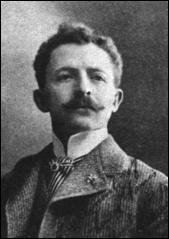 Charlie Harris got the idea to write After
The Ball during an incident he had witnessed in
Chicago
some years earlier while attending a formal ball. After the last dance, while Charlie and his friends were leaving,
he happened to overhear a quarrel between an attractive young lady and her
escort. The man finally
turned on his heel and went home in a huff, leaving her behind. She then burst into tears and left unescorted, which was quite an
embarrassment. The
scene left a lasting impression on Chuck Harris, who had a soft
spot in his heart for women. Later
that year Harris returned to
Milwaukee and completed perhaps the work of his lifetime.
Charlie Harris got the idea to write After
The Ball during an incident he had witnessed in
Chicago
some years earlier while attending a formal ball. After the last dance, while Charlie and his friends were leaving,
he happened to overhear a quarrel between an attractive young lady and her
escort. The man finally
turned on his heel and went home in a huff, leaving her behind. She then burst into tears and left unescorted, which was quite an
embarrassment. The
scene left a lasting impression on Chuck Harris, who had a soft
spot in his heart for women. Later
that year Harris returned to
Milwaukee and completed perhaps the work of his lifetime.
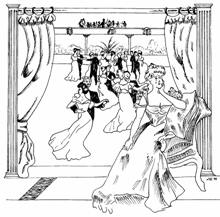 The
song is a story told by an old man to his little niece, the story of a woman that he had once taken to a ball when he was young.
He went to get her a glass of water and, upon returning, found
her in the arms of somebody else. Full
of anger, hostility, and disappointment, he left her then and there,
never to speak to her again, and she died of a broken heart. Years later the old man found out that the “other man” was
the young lady’s brother.
The
song is a story told by an old man to his little niece, the story of a woman that he had once taken to a ball when he was young.
He went to get her a glass of water and, upon returning, found
her in the arms of somebody else. Full
of anger, hostility, and disappointment, he left her then and there,
never to speak to her again, and she died of a broken heart. Years later the old man found out that the “other man” was
the young lady’s brother.
The gentle and lilting melody has
been a favorite from its first release. After the Ball’ is synonymous with the “Gay Nineties”, that
everlasting period of slow waltzes and broken hearts, canoe rides and
parasols. The song itself continued
to sell for the next 15 years. It
is said to have eventually sold about 6 million copies, and it has become a
part of our history.
After the
ball is over, after the break of morn,
After the dancers leaving, after the
stars are gone,
Many a heart is aching, if you could
read them all;
Many the hopes that have vanish’d
after the ball.[3]
My Gal Sal
 My Gal Sal was the swan song of Paul Dresser,
one
of the better known writers of Tin Pan Alley.
He had come to
New York
in 1886, and made his mark on the music industry by 1899 with his first big song, On the Banks on the
Wabash. By 1905, Dresser
was down on his luck, seriously overweight, poor, and in failing health.
Still, Paul Dresser took one last shot at fame and fortune. Just recently he had acquired the friendship of a young woman and
wrote a song about her. He
waived the manuscript of this recently written song in front of one of his
friends and said sadly, “Here is a song that should sell a million
copies, but I don’t have a dime to push it with”.[4]
He died the next day, probably of a heart attack, but Tin Pan
Alley forever maintained the legend that he died of a broken heart.
My Gal Sal was the swan song of Paul Dresser,
one
of the better known writers of Tin Pan Alley.
He had come to
New York
in 1886, and made his mark on the music industry by 1899 with his first big song, On the Banks on the
Wabash. By 1905, Dresser
was down on his luck, seriously overweight, poor, and in failing health.
Still, Paul Dresser took one last shot at fame and fortune. Just recently he had acquired the friendship of a young woman and
wrote a song about her. He
waived the manuscript of this recently written song in front of one of his
friends and said sadly, “Here is a song that should sell a million
copies, but I don’t have a dime to push it with”.[4]
He died the next day, probably of a heart attack, but Tin Pan
Alley forever maintained the legend that he died of a broken heart.
Your troubles, sorrows, and care,
She was always willing to share.
A mild sort of devil, but dead on the
level,
Was my gal Sal.[5]
Bird in a Gilded Cage
Harry Von Tilzer did something crazy,
hw wrote a parody. It turned out to be a poignant ballad about a girl who sold her
love to a rich old man. Ironically,
Von Tilzer wrote the song as a joke, a spoof of the tearjerker craze.
He meant for the song to be so stupid, so silly that people would
simply laugh. Harry could
not understand the popularity of such sentimental
drivel as After the Ball, and Little Lost Girl. He
had little sympathy for all the fabricated and overdone pathos that
flowed from so many of these songs. He felt that intelligent, urbane, metropolitan people, like those
living in New York, surely didn’t fall for the ridiculously sad material anymore.
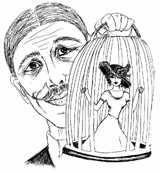 So in
late 1899, Harry and his close friend, Art Lamb, were tossing around the
idea of writing a take-off on tearjerker songs, which would sound so
lugubrious that it would put all tearjerkers to shame. Lamb handed Von Tilzer some words and said, “I dare you to set
this to music.” Harry
casually stuck the words in his vest pocket and turned his attention to
other things.[6]
So in
late 1899, Harry and his close friend, Art Lamb, were tossing around the
idea of writing a take-off on tearjerker songs, which would sound so
lugubrious that it would put all tearjerkers to shame. Lamb handed Von Tilzer some words and said, “I dare you to set
this to music.” Harry
casually stuck the words in his vest pocket and turned his attention to
other things.[6]
A few days later, Harry joined some
friends in their usual Saturday night barhopping marathon, and ended up
in a house of unfavorable reputation. Since he was not particularly interested in joining in the
activities, he reached into his vest pocket and pulled out the words to
the “satire”. Feeling awkward at being board in the midst of merriment, and having
time on his hands with nothing else to do, he made the best of things, sat
down at the piano and composed a melody around the words.[7]
It wasn’t too much later that he had a song, and in his strong
baritone voice, began to sing. A
pall of silence fell over the house. Young girls, who were sitting close by, began to sob faintly.
Harry looked up and found himself surrounded by tearful young
ladies. He couldn’t
believe it.
She’s only a bird in a guilded
cage,
A beautiful sight to see.
You may think she is happy and free
from care,
She’s not though she seems to be.
It’s sad when you think of her
wasted life,
For youth cannot mate with age.
And her beauty was sold for an old
man’s gold,
She’s a bird in a guilded cage.[8]
Harry had composed the song of the
year, the “bird cage” song. What
began as a tearjerker put-on turned out to be the biggest hit of 1900. Bird in A Gilded Cage had the distinction of ringing in the new decade and the new century
as well.
Daisy Bell
In 1892, Harry Dacre, an Englishman
coming to America by steamer, was walking down the gangway carrying under his arm his most prized
possession, his bicycle. At
the foot of the ramp he was stopped by a customs inspector, who slapped
an import duty on his bike.
When the surprised immigrant
recounted the incident to fellow songwriter, William Jerome, his friend
replied, ”Well, just be glad it wasn’t a bicycle built for two.
Then they would have charged you double.”
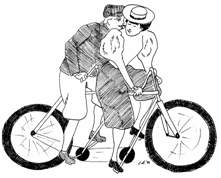 The
words had a ring to them and Harry spent the next several weeks thinking
about what he could do with the phrase, “a bicycle built for two.”
He eventually wrote a catchy ballad about a young man who
couldn’t afford an expensive wedding, but who could afford a bike for
himself and his bride. Unable
to find a publisher, Harry gave the song to a friend who was going to England, and there it became a smash hit.
The new English songs popularity spread back to America
and in 1892 alone, Daisy Bell
sold over 2 million copies. 1892
was indeed a great year for music.
The
words had a ring to them and Harry spent the next several weeks thinking
about what he could do with the phrase, “a bicycle built for two.”
He eventually wrote a catchy ballad about a young man who
couldn’t afford an expensive wedding, but who could afford a bike for
himself and his bride. Unable
to find a publisher, Harry gave the song to a friend who was going to England, and there it became a smash hit.
The new English songs popularity spread back to America
and in 1892 alone, Daisy Bell
sold over 2 million copies. 1892
was indeed a great year for music.
Daisy,
Daisy, give me your answer true.
I’m half crazy, all for the love of
you.
It won’t be a stylish marriage.
I can’t afford a carriage,
But you’ll look sweet, upon the
seat
Of a bicycle built for two.[9]
The bicycle was
highly popular at this time, and like
the bicycle, Daisy Bell
continued to sell very well for the next 12 years, until
automobiles came along, but until then the destinies of both Daisy
Bell and the bicycle were connected.
The Band Played On
John Palmer was a out-of-work
actor when he wrote The Band
Played On. The title
phrase occurred to him when he was living with his sister in Manhattan.
He was shaving when she
called him downstairs to breakfast. “Hurry
up John, I’ve got your breakfast on the table!” she said. John hardly heard her; he was
standing by the window watching an itinerant German band play across the
street. “John, you didn’t hear a word I
said. Are you coming down,
or not?” She asked again.
John
replied “I’ll be down in
a second. I want to hear the
band play on.”[10]
When he finally did come downstairs,
his sister somewhat sarcastically said “And all this time since I
first called you, the band played on.”
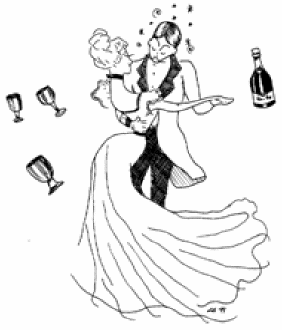 At
this point John realized that the words could become a great title for a
song. The next day he wrote
the story of a friend of his, Matt Casey, who had an intense
relationship with a strawberry blonde. According to the song, she eventually became Mrs. Casey.
Palmer worked out a melody and tried to sell the song to Tin Pan
Alley with no takers. Finally an
ambitious young comedian actor from the Bowery named Charlie Ward made
some changes to the song and, by his own efforts, got it published.
At
this point John realized that the words could become a great title for a
song. The next day he wrote
the story of a friend of his, Matt Casey, who had an intense
relationship with a strawberry blonde. According to the song, she eventually became Mrs. Casey.
Palmer worked out a melody and tried to sell the song to Tin Pan
Alley with no takers. Finally an
ambitious young comedian actor from the Bowery named Charlie Ward made
some changes to the song and, by his own efforts, got it published.
Casey
would waltz with a strawberry blonde
And the band played on.
He’d glide ‘cross the floor
With the girl he adored,
And the band played on.
But his brain was so loaded
It nearly exploded.
The poor girl would shake with alarm.
He’d ne’er leave the girl
With the strawberry curls
And the band played on.[11]
Critics condemned this song. They said that it had no artistic value and that all of its
technical aspects were flawed. The
public apparently felt that it was the critics’ judgment that was
flawed. Consumers of popular
music loved the song and bought over a million copies of it.
The Curse
Paul Dresser carried a lot of weight,
emotionally as well as physically, and he put all of his 300 pounds into
his vaudeville stage act. To
describe his performance as impressive is an understatement. He was a man of extremes, sometimes very happy, sometimes very
unhappy, most of the time unhappy. This
was obvious in his music as well as in the affairs of his heart.
His marriage some time earlier to May
Howard was certainly no exception, for after a whirlwind honeymoon, they
separated, going their individual ways in pursuit of their own acting careers, and May continued to seek the kinds of worldly
pleasures and companionship she had been accustomed to before
they got married.
Paul Dresser had his dark
side, for while separated he wrote a song, intended to be sung to his
errant wife. For that
reason, at every one of his performances, he reserved a box in the hope
that some day she would do him the courtesy of attending one of his
shows. Finally, after
continued invitations, she did come. Paul Dresser, with his overpowering stage presence and in his
rich baritone voice, sang The Curse. This was the
first and only time the song was performed, because the music was
destroyed immediately after this performance. It is somewhat frightening to describe what happened.
We do know that women began screaming and fainting and crying. After the first chorus, many covered their ears, and many
more left the theater. May
Howard sat motionless throughout the song. She was never able to perform on stage again.
She had been completely and thoroughly undone by the episode. Paul
Dresser had visited his intense unhappiness upon his wife, whether or
not she deserved it.
My Gal is a High Born lady
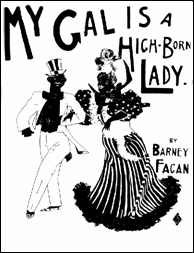 The
song My Gal is a High Born Lady had everything needed to make it a ragtime hit;
great melody, good lyrics, and something altogether unique--ragtime
syncopation. It is
significant not only because it was the first true popular ragtime song,
but because it influenced many songs that came after it. The unusual dance step that it produced was very much like a fox
trot. However, its
slow-slow-quick-quick rhythm was not to get an appropriate name for
another 17 years, when Harry Fox introduced his fox trot dance
step. The ragtime trend that
My Gal started was to continue
for the next 20 years. Soon
after it came even bigger hits like Hello,
My Baby and Bill Bailey.
The
song My Gal is a High Born Lady had everything needed to make it a ragtime hit;
great melody, good lyrics, and something altogether unique--ragtime
syncopation. It is
significant not only because it was the first true popular ragtime song,
but because it influenced many songs that came after it. The unusual dance step that it produced was very much like a fox
trot. However, its
slow-slow-quick-quick rhythm was not to get an appropriate name for
another 17 years, when Harry Fox introduced his fox trot dance
step. The ragtime trend that
My Gal started was to continue
for the next 20 years. Soon
after it came even bigger hits like Hello,
My Baby and Bill Bailey.
Barney Fagan got the inspiration for
this song from, as he says, a broken bicycle pedal. He was riding home on his bike, dividing his attention between
the song he was thinking about and the worries he had about finding
enough money to buy his wife a birthday present.
Fagan was immediately struck by the unusual floppidy-flop rhythm
that the loose bike pedal created. Barney
suddenly realized that he could make the music he was working on fit
into this crazy “ragged” floppidy-flop rhythm, so he stopped, sat down by the side of the road, and composed
several measures. When Barney got
home he finished the first popular ragtime song, sold the piece for
$100, and bought his wife a birthday present.
Sidewalks
of
New York
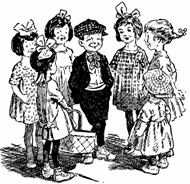 Charles Lawlor wrote the music and
James Blake wrote the words to Sidewalks
of New York in 1894. More
than a century later, it is alive and well as the anthem of
New York City. The collaboration between
Lawlor and Blake began when Lawlor was looking for a new derby in a hat
shop where Blake worked. Lawlor,
a song-and-dance man in vaudeville, was humming a tune he had just made
up out of the blue. Blake liked it and asked
if he could try writing words to it[12].
For the rest of the day, between customers, Blake wrote. The words came easily because they were all about things he knew.
Charles Lawlor wrote the music and
James Blake wrote the words to Sidewalks
of New York in 1894. More
than a century later, it is alive and well as the anthem of
New York City. The collaboration between
Lawlor and Blake began when Lawlor was looking for a new derby in a hat
shop where Blake worked. Lawlor,
a song-and-dance man in vaudeville, was humming a tune he had just made
up out of the blue. Blake liked it and asked
if he could try writing words to it[12].
For the rest of the day, between customers, Blake wrote. The words came easily because they were all about things he knew.
Down in front of Casey’s old brown
wooden stoop,
On a summer’s evening we formed a
merry group.
Boys and girls together, we would
sing and waltz
While the Ginnie play the organ on
the sidewalks of New York.
Chorus:
East-side,
west-side, all around the town
The tots sing Ring-a-Rosie, London Bridge is falling down,
Boys and girls together, me and Mamie
O’Rourke,
Trip the light fantastic on the
sidewalks of New York.
That’s where Johnny Casey and
little Jimmy Crowe,
With Jakey Kruse, the baker, who
always had the dough,
Pretty Nellie Shannon, with a dude as
light as cork,
First picked up the waltz step on the
sidewalks of New York.[13]
The verses Blake wrote memorialized
his own growing up in New York. The house next door had a
brown stoop and belonged to a man named Higgins (Casey in the song
because it sounded better). They
bought their bread from old Jakey Kruse who owned a bakery down the
street. Jimmy was taught the
slow waltz by a neighbor girl named Mamie O’Rourke. His best friends were Johnny Higgins and Jimmy Crowe.
There was a beautiful young girl down the street named Nellie
Shannon, and she was dating a “dude” who dressed in flashy clothes.
Sidewalks
sold many copies and became extremely popular in the city. Governor Al Smith renamed it
East
Side, West Side and used it as his theme when he ran for president in 1928.
Wait Till the Sun Shines, Nellie
Harry Von Tilzer said this song was
his greatest work.[14]
He was the most respected and productive songwriter of the
period, the man whose works sold more copies of sheet music than any
other songwriter. This song quickly
sold well over a million copies in 1905.
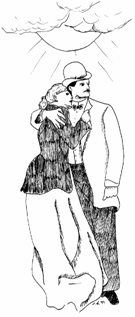 Harry
had an amazing ability to observe people and use everyday situations as inspiration for
his songs. He
could see melody right in front of his eyes, and one simple incident
often would set him going. Sometimes
the melody came first, but usually he needed just the right words or the
right image.
Harry
had an amazing ability to observe people and use everyday situations as inspiration for
his songs. He
could see melody right in front of his eyes, and one simple incident
often would set him going. Sometimes
the melody came first, but usually he needed just the right words or the
right image.
In this case he was going home one afternoon
when he got caught in a big rainstorm. The
only shelter available was a nearby doorway where people were already
huddled to get away from the rain. As
Harry ducked into the doorway, he noticed a young man and
his girl friend, who was softly sobbing. The sudden rainstorm had ended their plans for a fun day at Coney Island,
and the man whispered to
his sweetheart, “Wait till the sun shines, Nellie.”
This single phrase and this image set
bells ringing in Harry’s head. He
raced back to his apartment, frantically worked out a melody to fit the
“Nellie” song, and asked his longtime friend and confidant, Andy
Sterling to help do the words. With
Nellie, Von Tilzer had completed his finest work.
Wait till the sun shines, Nellie,
When the clouds go drifting by,
We’ll be so happy, Nellie,
Don’t you cry.
Down lovers’ lane we’ll wonder,
Sweethearts you and I,
Wait till the sun shines, Nellie,
Bye and bye.[15]
I Wonder Who’s Kissing Her Now
Harold Orlob and William Hough were
hard at work in 1909 on a Broadway play. Collaborating on a play is an association that often lasts a long
time, perhaps a year or more. Songwriters,
on the other hand, often work together no more than a few days.
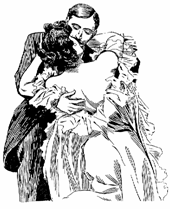 This
is what happened when the two men wrote
I Wonder Who’s Kissing Her Now. They were at a party and overheard some of the disappointed male
guests grumbling that a very popular young lady had not
shown up. One of the
impatient young men whispered under his breath, “I wonder who’s
kissing her now?” The
phrase and the situation inspired the two songwriters, who put this song
together over the next few weeks. They
included it in the musical play that they had been working on, The
Prince for Tonight. The
song was a giant success and is still done today, but the play flopped.
This
is what happened when the two men wrote
I Wonder Who’s Kissing Her Now. They were at a party and overheard some of the disappointed male
guests grumbling that a very popular young lady had not
shown up. One of the
impatient young men whispered under his breath, “I wonder who’s
kissing her now?” The
phrase and the situation inspired the two songwriters, who put this song
together over the next few weeks. They
included it in the musical play that they had been working on, The
Prince for Tonight. The
song was a giant success and is still done today, but the play flopped.
I wonder who’s kissing her now.
I wonder who’s teaching her how.
I wonder who’s looking into her
eyes,
Breathing sighs, telling lies.
Sweet Adeline
 Henry Armstrong and Richard Gerard
wrote the song Sweet Adeline in
1903 but they couldn’t get anybody to publish it. At first, they called the song Sweet
Rosalie. Unfortunately a lot of other Rosalie type songs were on the market, but they were still
undeterred. Nevertheless Sweet Rosalie
laid around for seven years gathering dust. Gerard was just about ready to give up when he learned that his
friend, Fred Rycroft, needed a good quartet song for his new barbershop
quartet, The
Quaker City Four. When
Gerard changed the name of the song to Sweet
Adeline, the chemistry of the change propelled the song into immortality.
Henry Armstrong and Richard Gerard
wrote the song Sweet Adeline in
1903 but they couldn’t get anybody to publish it. At first, they called the song Sweet
Rosalie. Unfortunately a lot of other Rosalie type songs were on the market, but they were still
undeterred. Nevertheless Sweet Rosalie
laid around for seven years gathering dust. Gerard was just about ready to give up when he learned that his
friend, Fred Rycroft, needed a good quartet song for his new barbershop
quartet, The
Quaker City Four. When
Gerard changed the name of the song to Sweet
Adeline, the chemistry of the change propelled the song into immortality.

Sweet Adeline,
My Adeline,
At night sweet heart,
For you I pine.
 In all my
dreams,
In all my
dreams,
Your fair
face beams,
You’re the
flower of my heart,
Sweet
Adeline[18]
The song completely went off the charts.
From that day forward we have been blessed with the flowing
strains of the premier barbershop song of all time.
 In
Boston, John J. Fitzgerald ran for Mayor using Adeline as his theme song.
Soon,
whenever he appeared at rallies or gatherings, everyone spontaneously
burst into close harmony. This
practice spread to the inebriated, and the citizens of Boston
were treated to a constant spectacle of groups of drunken singers
un-harmoniously attempting to perform this song at all hours of the day
and night. Things got so bad that Boston
officials seriously considered passing an ordinance that would outlaw
the singing of Sweet Adeline
within the city limits.[19]
Sweet Adeline came
close to being banned in
Boston.
In
Boston, John J. Fitzgerald ran for Mayor using Adeline as his theme song.
Soon,
whenever he appeared at rallies or gatherings, everyone spontaneously
burst into close harmony. This
practice spread to the inebriated, and the citizens of Boston
were treated to a constant spectacle of groups of drunken singers
un-harmoniously attempting to perform this song at all hours of the day
and night. Things got so bad that Boston
officials seriously considered passing an ordinance that would outlaw
the singing of Sweet Adeline
within the city limits.[19]
Sweet Adeline came
close to being banned in
Boston.
Casey Jones
When Casey Jones appeared in
print, Lawrence Seibert and Eddie Newton were credited with writing of
both words and music, but these two men were probably not the original authors, at least not
totally. Seibert and Newton
first heard the melody when some railroad workers were humming it and
decided it could be made into a decent song.
Railroad crews were accustomed to applying the
same music to various railroad catastrophes, using this tune and making
up different words to go with each new catastrophe. In this case they were singing about a certain railroad engineer Casey
Jones, who was involved in a tragic train wreck some years earlier.
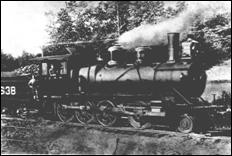 It was on the night of Sunday, April
29, 1900, engineer John Luther Jones drove the fast cannonball express
out of Memphis. Simian Taylor Webb was the
fireman on board. The
regular engineer was sick and Casey and Sim Webb were called up as substitutes.
They were already eight hours late so you might say they were
both in a big hurry, highballing it, as the yardbirds[20]
say. When engine number 382
came around a bend with Casey at the throttle, the two found themselves
looking at the back of a freight car that was standing still on the
track directly in front of them. Casey
told Sim Webb to jump, and moments later, with Jones still at the
throttle trying to stop the speeding locomotive, the fast
cannonball express slammed into the freight train. Jones was killed instantly.
Webb
lived to tell the story[21]
It was on the night of Sunday, April
29, 1900, engineer John Luther Jones drove the fast cannonball express
out of Memphis. Simian Taylor Webb was the
fireman on board. The
regular engineer was sick and Casey and Sim Webb were called up as substitutes.
They were already eight hours late so you might say they were
both in a big hurry, highballing it, as the yardbirds[20]
say. When engine number 382
came around a bend with Casey at the throttle, the two found themselves
looking at the back of a freight car that was standing still on the
track directly in front of them. Casey
told Sim Webb to jump, and moments later, with Jones still at the
throttle trying to stop the speeding locomotive, the fast
cannonball express slammed into the freight train. Jones was killed instantly.
Webb
lived to tell the story[21]
Seibert write four verses for the
song, using the same melody he had picked up from the railroad workers, while
Newton arranged words around the melody.[22]
At first they had difficulty getting any publisher to look at the
song, but eventually it became a big seller, and highballing Casey was forever after an American legend.
On the banks of the
Wabash
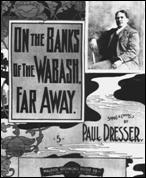 On the banks of the Wabash became Paul Dresser’s big success
story. He wrote it after a
conversation with his brother, Theodore Dreiser[23],
who himself was later to become noted as a journalist and writer. Paul was feeling frustrated by the elusiveness of first-rate
success in the songwriting business. Theodore suggested that he write about something that he knew,
something about home, something that he was familiar with. “Why not write about the good old Wabash
and those fine sycamores growing along its banks?”[24]
Said Ted.
On the banks of the Wabash became Paul Dresser’s big success
story. He wrote it after a
conversation with his brother, Theodore Dreiser[23],
who himself was later to become noted as a journalist and writer. Paul was feeling frustrated by the elusiveness of first-rate
success in the songwriting business. Theodore suggested that he write about something that he knew,
something about home, something that he was familiar with. “Why not write about the good old Wabash
and those fine sycamores growing along its banks?”[24]
Said Ted.
Paul was inspired by his brother’s
words and went into his customary feverish activity, worked all night and
came up with a winner. On
the Banks of the Wabash was Paul Dresser’s masterpiece, sold well
over a million copies, and became understandably popular in Indiana, so much so that it soon was voted Indiana’s theme song.
This
experience gave Dresser renewed inspiration and propelled his faltering career into
serious songwriting. Although
he would never write another really successful song until just before he
died, this single song became the trademark of his life, and Indiana’s trademark as well.
My Old New Hampshire Home
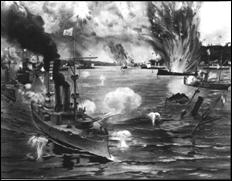 This
song has not stood the test of time, as is the case with other songs in this section.
It was unbelievably popular in 1898, selling two million copies and
launching the Sterling-Von Tilzer team into stardom.
This
song has not stood the test of time, as is the case with other songs in this section.
It was unbelievably popular in 1898, selling two million copies and
launching the Sterling-Von Tilzer team into stardom.
Harry Von Tilzer and Andy Sterling
had rented an apartment together. They
were about two weeks behind on the rent, so one night they silently crept up to their third-floor apartment,
afraid to turn on the light for fear the manager would catch them and
throw them out. Andy placed
a sheet of paper against the windowpane (some say this piece of paper
was the rent notice) and, using the street lamp for light, wrote the
words to a song which commemorated Dewey’s victory at Manila
during the Spanish American war. Harry
put the words to music. They
were able to sell the song to a publisher, William Dunn for $5, and
later received an additional $10 after Dunn’s daughter told her publisher father that she liked
it very much. Dunn made considerable profit on the venture and Andy and Harry
were able to pay the rent.[25]
I’m Afraid to Come Home in the Dark
1905 and 1906 were good years for the
dynamic team of Harry Williams and Egburt Van Alstyne. They were able to put together several songs during this period,
songs such as In the Shade of the
Old Apple Tree, Cheyenne, Won’t You Come Over to My House, Why Don’t You Try, and
I’m Afraid to Come Home in the Dark. The last song was not the biggest hit, but it did
turn out to be a big hit in
New York City. In fact there were few places in town where the sonorous sounds of this
soft waltz were not heard.
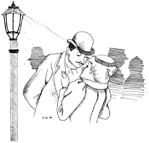 O.
Henry, the mystery writer, loved this song. His real name was William Sydney Porter, and he began writing
short stories when he was in prison serving a two-year term for
embezzlement. He claimed
that he was framed, but then there was a mystery to that story. After Porter got out of prison he went to New York
to continue his career in writing short stories. In the few years left to him before his death he became a famous
writer, and an extremely familiar figure of his day on West 26th Street, Manhattan.
O.
Henry, the mystery writer, loved this song. His real name was William Sydney Porter, and he began writing
short stories when he was in prison serving a two-year term for
embezzlement. He claimed
that he was framed, but then there was a mystery to that story. After Porter got out of prison he went to New York
to continue his career in writing short stories. In the few years left to him before his death he became a famous
writer, and an extremely familiar figure of his day on West 26th Street, Manhattan.
By 1910 the short story writer was at
death’s door. He lay in deep coma in his darkened room at the Caledonia Hotel.
One afternoon he suddenly awoke from his coma at the sound of a
hurdy-gurdy[26]
outside his window playing his favorite melody, I’m Afraid to Come Home in the Dark. The surprised nurse rushed to Porter’s bedside to hear his
dying words, “Pull up the curtain, I’m afraid to come home in the
dark”.[27]
Nobody could figure out exactly what he meant. O. Henry ended his life as he had lived it, with one more
mystery.
I’d
Leave My Happy Home For You
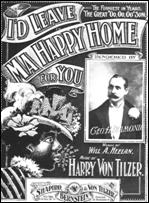 In 1899 Harry Von Tilzer was still
struggling to make a name for himself.
Among his many skills, he was above all an accomplished piano player and was accompanying a play
in Hartford
Connecticut. A girl waited for him at
the stage door after one of the practices. She
told Harry she wanted to go to New York with him and become famous too.
Harry
said something offhand like “Well pack your bags and come along”.
In 1899 Harry Von Tilzer was still
struggling to make a name for himself.
Among his many skills, he was above all an accomplished piano player and was accompanying a play
in Hartford
Connecticut. A girl waited for him at
the stage door after one of the practices. She
told Harry she wanted to go to New York with him and become famous too.
Harry
said something offhand like “Well pack your bags and come along”.
A few days later, when the company
was about to leave, there she was, bags all packed and ready to go.
Harry gently tried to talk the girl out of coming to New York with him.
She took him to a
window, and pointed to her home, a magnificent house on the nearby hill.
“Oh Harry, I’d leave my happy home for you.”[28]
She said.0
I'm not sure how he got out of this
jam, but Harry wasn’t really ready to enter
into a full-time relationship with a rich, stage-struck girl. Her
words did made a kind of sense to him. He
immediately banged out a sketchy melody and asked a friend of his, Will
Heelan, to write lyrics for it using the phrase “I’d leave my
happy home for you”. Harry
got the song published and Harry’s friend, Blanche Ring, the Broadway
singer, popularized it. The
song became a million seller.[29]
When you were Sweet Sixteen
Jim Thornton was a successful
stand-up comedian. He was
also John L. Sullivan’s
favorite drinking buddy and piano player. This led to a life of serious bar hopping and even more serious
drinking. His wife Bonnie,
always one to worry about his health, once pouted. “Don’t you love me anymore, Jim?”
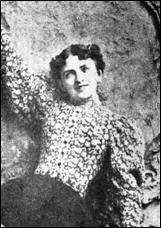 Never at a loss for words, Big Jim
quickly responded, “Why I love you like I did when you were sweet
sixteen.”
Never at a loss for words, Big Jim
quickly responded, “Why I love you like I did when you were sweet
sixteen.”
From this reply Jim was inspired to
work on a song which he completed in about two days of frantic
work. In the trouble-making
style that was characteristic of him, Thornton
sold the song for practically nothing to two different publishing houses
at the same time. Perhaps he
did it to make things interesting. The song sold millions and the two publishers, John W. Witmark
& Co., and Joseph W. Stern & Co. took the issue to court and
fought over copyright for the next 50 years. The copyright finally expired in 1944.
Jim had certainly made things interesting.
I love you as I never loved before,
Since first I met you on the village
green.
Come to me or my dream of love is
o’er.
I love you as I loved you
When you were sweet,
When you were sweet sixteen.[31]
Rufus Rastus Johnson Brown
Harry Von Tilzer was returning to
New York
after a visit to
Miami. While he was standing on
the wooden platform waiting for a train, he overheard a loud
conversation. “What you gonna’ do about the
rent? What you gonna’ say
to the landlord when he comes ‘round. You ain’t got no sense and you won’t have any on Judgment
Day!”
On his long trip back to New York
Harry turned the words over in his mind. When he got back he told his close friend Andy Sterling about the
incident. Together they
wrote this catchy ragtime song.[16]
Rufus Rastus Johnson Brown,
What you goin’ to do when the rent
comes ‘round?
What you goin’ to say, how you goin’
to pay
You’ll never have a bit of sense
till Judgment day.[17]
When I Lost You
This was the only sad song Irving
Berlin ever wrote, and it was completely based on his own experience.
In 1911, when the very successful songwriter was signing copies
of new music at his publishing house, two young women got
into a fight over a copy with his signature on it. Berlin
remarked later ”I used to dream of people fighting for the right to
sing my stuff, but this was the first time I saw that dream come
true”.[32]
He settled the argument this way. He gave the sheet music to one of the women and took the other
one out on a date. Her name
was Dorothy Goetz, the sister of Ray Goetz, a theatrical producer.
Dorothy Goetz was a petite brunette,
and within weeks the two were hopelessly in love and six months later
they were married. The
newlyweds escaped the cold weather of New York
City and went to Cuba
for their honeymoon, but an outbreak of typhoid fever in Havana
caused them to cut their vacation short. After their return, Dorothy became ill and she died of typhoid
fever five months later.
The tragically brief marriage left
this 23-year-old man devastated. He could not rid himself of despair and guilt feelings that
somehow he was responsible for his wife’s death. He had lost everything: his homeland, his father, his singing
career, and now his young wife. The
only thing left to him was his amazing songwriting ability.
To pay homage to his lost love, Berlin
did what he was best at, and wrote a song. When I Lost You was unusual, for this majestic waltz, done in slow
three-quarter time, hinted at a funeral dirge; its use of soft
diminished seventh’s almost gave one hope. The public proved that Berlin’s belief, that sad music doesn’t sell was wrong, when they
purchased well over a million copies.
My Melancholy baby
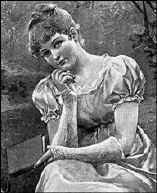
My
Melancholy baby was written in 1912. It is remarkable in several ways.
The authors, Earnest Burnett and George Norton, did little else
in the way of music, although Norton later composed the words for Memphis
Blues. The song had an
unusual title. It sputtered
out in 1912 and moldered away for almost 30 years, until Bing Crosby
dusted it off and made it a hit in 1939. The song was perfectly suited for the 1940’s era, and became
the first torch song ever written.[33]
It was simply written 30 years too early.[34]
Sweet Rosie O’Grady

Maude Nugent was a singer and dancer
in New York City
who in 1895 married Broadway songwriter Billy Jerome. She decided to try her hand at songwriting, and composed a soft
ballad called Sweet Rosie
O’Grady. Shy by
nature, she told no one about it for several weeks, even her songwriter
husband. When Maude finally
showed him what she had written, he was impressed and advised her to try
using it onstage. She
performed her song and brought the house down. Nugent became the first woman to write a modern American hit.[35]
Hot Time in the
Old
Town
Tonight
There is not much uncertainty about
who wrote Hot Time in
the Old Town Tonight but there is some question about where they got
the song. Ted Metz
presumably came up with the melody and some of the words, but the tune
was known to have been a well-established favorite at Babe Connors’
St. Louis
brothel well before Ted Metz ever heard of it.
Ted Metz had been to Babe’s and was
at least subconsciously familiar with the melody when the minstrel show
he was with stopped at a railroad junction near Old Town,
Louisiana. Some kids were playing
nearby and had built a huge bonfire, which spread to some nearby
railroad ties. Members of
the minstrel show piled out of the train and rushed to help local Old
Town
residents control the fire. In
the midst of all this pandemonium, one of the performers remarked glibly,
“They’ll be a hot time in the Old
Town
tonight!”
This phrase formed the core of a set
of lyrics that Metz
set to music, using the snappy melody he had remembered from Babe
Connors’ brothel. Joe
Hayden, a member of the minstrel group, helped him with the words.
From 1896 on, almost every minstrel show began its program with Hot Time. Two years
later, Teddy Roosevelt and his Rough Riders charged up San Juan Hill
to this song. Hot Time was then adopted by American soldiers as the unofficial
Spanish American War song.

AFTER THE
WAR
“Welcome
home! Are you one of the heroic 71st?”
“No, I ain’t no hero. I’m
a regular.”
Charles
Dana Gibson, 1898.
Here are some other links in this
article:
Origins
of Early Popular Music
Minstrelsy
Broadway
Vaudeville
Other sources
People
Growth - the First Baby Boom and it's effect
How
Dancing Helped Music
Women
and Early Music
Some
Early Songwriters
The
Influence of the Piano
Recorded
Music
Sheet Music
Chronicles
1892-1900
Chronicles
1901-1915
Million
Sellers
[1]
Andrew Sterling and Kerry Mills, Meet
Me in St. Louis, Louis, 1904.
[2]
Maxwell F. Marcuse, Tin
Pan Alley In Gaslight (New York: Century House, 1959), 140.
[3]
Charles K. Harris, After the
Ball, 1892.
[4]
Marcuse, 128.
[5]
Paul Dresser, My Gal Sal,
1905.
[6]
Some historians suggest that Harry objected to the lyrics: the young
girl had to be married to the old man and not just his paramour, and
Von Tilzer insisted that Lamb rewrite the lyrics. Douglas Gilbert, (Lost
Chords, Cooper Square Publishers, 1970, p.318) states that it
was Bernstein, the publisher, who made Lamb change the lyrics and
not Von Tilzer at all. Gilbert’s
version may be more credible because two years later the same team
of Lamb & Von Tilzer wrote a follow-up song about a whorehouse
called Mansion of
Aching Hearts.
[7]
Sigmund Spaeth, Read ‘em and
Weep (New York: Arco Publishing Company, 1945), 205.
[8]
Andrew Lamb & Harry Von Tilzer,
Bird in a Guilded Cage, 1900.
[9]
Harry Dacre, Daisy Bell, 1892.
[10]
Marcuse, 174.
[11]
Palmer & Ward, Band Played
On, 1895.
[12]
Gilbert, 257.
[13]
Blake & Lawlor, Sidewalks
of New York, 1894.
[14]
Marcuse, 329
[15]
Andrew Sterling & Harry Von Tilzer, Wait
Till The Sun Shines, Nellie, 1905.
[16]
Marcuse, 328
[17]
Andrew Sterling & Harry Von Tilzer, What
You Going To Do When the Rent Comes Round, 1905.
[18]
Girard & Armstrong, Sweet
Adeline, 1903.
[19]
Marcuse, 305
[20]
People who work in the train yards.
[21]
The New York Times, July,
1957.
[22]
Marcuse, 411.
[23]
Paul had changed his name to Dresser when he went into song writing.
It sounded more American.
[24]
Marcuse, 229.
[25]
Burton
, 133.
[26]
A type of hand cranked organ used by street vendors.
[27]
Burton
, 129.
[28]
Spaeth, 209.
[29]
Burton
, 134.
[30]
John L. Sullivan (1858-1918), known as “The Great John L,” held
the world heavyweight boxing title for 10 years from 1882 until 1892
when he was knocked out by “Gentleman Jim” Corbett in 21 rounds.
[31]
Jim Thornton, When You Were
Sweet Sixteen, 1898.
[32]
Laurence B Bergreen, As
Thousands Cheer. (New
York: Viking, 1990), 81.
[33]
Allec Wilder, American Popular
Song, (New York, Oxford University Press, 1972), 17.
[34]
The term “torch song” didn’t come into use until about 1927.
It describes any slow ballad containing a theme of unrequited
or lost love. The
expression “to carry a torch for someone” means that love is not
reciprocated, and that the other party does not accept the torch of
love.
[35]
Maude Nugent’s authorship is disputed by some who feel that her
husband wrote the songs and had her take responsibility because the
arrangement proved to be more successful. None of this was ever proved.
 Charlie Harris got the idea to write After
The Ball during an incident he had witnessed in
Chicago
some years earlier while attending a formal ball. After the last dance, while Charlie and his friends were leaving,
he happened to overhear a quarrel between an attractive young lady and her
escort. The man finally
turned on his heel and went home in a huff, leaving her behind. She then burst into tears and left unescorted, which was quite an
embarrassment. The
scene left a lasting impression on Chuck Harris, who had a soft
spot in his heart for women. Later
that year Harris returned to
Milwaukee and completed perhaps the work of his lifetime.
Charlie Harris got the idea to write After
The Ball during an incident he had witnessed in
Chicago
some years earlier while attending a formal ball. After the last dance, while Charlie and his friends were leaving,
he happened to overhear a quarrel between an attractive young lady and her
escort. The man finally
turned on his heel and went home in a huff, leaving her behind. She then burst into tears and left unescorted, which was quite an
embarrassment. The
scene left a lasting impression on Chuck Harris, who had a soft
spot in his heart for women. Later
that year Harris returned to
Milwaukee and completed perhaps the work of his lifetime. The
song is a story told by an old man to his little niece, the story of a woman that he had once taken to a ball when he was young.
He went to get her a glass of water and, upon returning, found
her in the arms of somebody else. Full
of anger, hostility, and disappointment, he left her then and there,
never to speak to her again, and she died of a broken heart. Years later the old man found out that the “other man” was
the young lady’s brother.
The
song is a story told by an old man to his little niece, the story of a woman that he had once taken to a ball when he was young.
He went to get her a glass of water and, upon returning, found
her in the arms of somebody else. Full
of anger, hostility, and disappointment, he left her then and there,
never to speak to her again, and she died of a broken heart. Years later the old man found out that the “other man” was
the young lady’s brother.
 So in
late 1899, Harry and his close friend, Art Lamb, were tossing around the
idea of writing a take-off on tearjerker songs, which would sound so
lugubrious that it would put all tearjerkers to shame. Lamb handed Von Tilzer some words and said, “I dare you to set
this to music.” Harry
casually stuck the words in his vest pocket and turned his attention to
other things.
So in
late 1899, Harry and his close friend, Art Lamb, were tossing around the
idea of writing a take-off on tearjerker songs, which would sound so
lugubrious that it would put all tearjerkers to shame. Lamb handed Von Tilzer some words and said, “I dare you to set
this to music.” Harry
casually stuck the words in his vest pocket and turned his attention to
other things. The
words had a ring to them and Harry spent the next several weeks thinking
about what he could do with the phrase, “a bicycle built for two.”
He eventually wrote a catchy ballad about a young man who
couldn’t afford an expensive wedding, but who could afford a bike for
himself and his bride. Unable
to find a publisher, Harry gave the song to a friend who was going to England, and there it became a smash hit.
The new English songs popularity spread back to America
and in 1892 alone, Daisy Bell
sold over 2 million copies. 1892
was indeed a great year for music.
The
words had a ring to them and Harry spent the next several weeks thinking
about what he could do with the phrase, “a bicycle built for two.”
He eventually wrote a catchy ballad about a young man who
couldn’t afford an expensive wedding, but who could afford a bike for
himself and his bride. Unable
to find a publisher, Harry gave the song to a friend who was going to England, and there it became a smash hit.
The new English songs popularity spread back to America
and in 1892 alone, Daisy Bell
sold over 2 million copies. 1892
was indeed a great year for music. At
this point John realized that the words could become a great title for a
song. The next day he wrote
the story of a friend of his, Matt Casey, who had an intense
relationship with a strawberry blonde. According to the song, she eventually became Mrs. Casey.
Palmer worked out a melody and tried to sell the song to Tin Pan
Alley with no takers. Finally an
ambitious young comedian actor from the Bowery named Charlie Ward made
some changes to the song and, by his own efforts, got it published.
At
this point John realized that the words could become a great title for a
song. The next day he wrote
the story of a friend of his, Matt Casey, who had an intense
relationship with a strawberry blonde. According to the song, she eventually became Mrs. Casey.
Palmer worked out a melody and tried to sell the song to Tin Pan
Alley with no takers. Finally an
ambitious young comedian actor from the Bowery named Charlie Ward made
some changes to the song and, by his own efforts, got it published.
 The
song My Gal is a High Born Lady had everything needed to make it a ragtime hit;
great melody, good lyrics, and something altogether unique--ragtime
syncopation. It is
significant not only because it was the first true popular ragtime song,
but because it influenced many songs that came after it. The unusual dance step that it produced was very much like a fox
trot. However, its
slow-slow-quick-quick rhythm was not to get an appropriate name for
another 17 years, when Harry Fox introduced his fox trot dance
step. The ragtime trend that
My Gal started was to continue
for the next 20 years. Soon
after it came even bigger hits like Hello,
My Baby and Bill Bailey.
The
song My Gal is a High Born Lady had everything needed to make it a ragtime hit;
great melody, good lyrics, and something altogether unique--ragtime
syncopation. It is
significant not only because it was the first true popular ragtime song,
but because it influenced many songs that came after it. The unusual dance step that it produced was very much like a fox
trot. However, its
slow-slow-quick-quick rhythm was not to get an appropriate name for
another 17 years, when Harry Fox introduced his fox trot dance
step. The ragtime trend that
My Gal started was to continue
for the next 20 years. Soon
after it came even bigger hits like Hello,
My Baby and Bill Bailey. Charles Lawlor wrote the music and
James Blake wrote the words to Sidewalks
of New York in 1894. More
than a century later, it is alive and well as the anthem of
Charles Lawlor wrote the music and
James Blake wrote the words to Sidewalks
of New York in 1894. More
than a century later, it is alive and well as the anthem of Harry
had an amazing ability to observe people and use everyday situations as inspiration for
his songs. He
could see melody right in front of his eyes, and one simple incident
often would set him going. Sometimes
the melody came first, but usually he needed just the right words or the
right image.
Harry
had an amazing ability to observe people and use everyday situations as inspiration for
his songs. He
could see melody right in front of his eyes, and one simple incident
often would set him going. Sometimes
the melody came first, but usually he needed just the right words or the
right image. This
is what happened when the two men wrote
I Wonder Who’s Kissing Her Now. They were at a party and overheard some of the disappointed male
guests grumbling that a very popular young lady had not
shown up. One of the
impatient young men whispered under his breath, “I wonder who’s
kissing her now?” The
phrase and the situation inspired the two songwriters, who put this song
together over the next few weeks. They
included it in the musical play that they had been working on, The
Prince for Tonight. The
song was a giant success and is still done today, but the play flopped.
This
is what happened when the two men wrote
I Wonder Who’s Kissing Her Now. They were at a party and overheard some of the disappointed male
guests grumbling that a very popular young lady had not
shown up. One of the
impatient young men whispered under his breath, “I wonder who’s
kissing her now?” The
phrase and the situation inspired the two songwriters, who put this song
together over the next few weeks. They
included it in the musical play that they had been working on, The
Prince for Tonight. The
song was a giant success and is still done today, but the play flopped. Henry Armstrong and Richard Gerard
wrote the song Sweet Adeline in
1903 but they couldn’t get anybody to publish it. At first, they called the song Sweet
Rosalie. Unfortunately a lot of other Rosalie type songs were on the market, but they were still
undeterred. Nevertheless Sweet Rosalie
laid around for seven years gathering dust. Gerard was just about ready to give up when he learned that his
friend, Fred Rycroft, needed a good quartet song for his new barbershop
quartet, The
Quaker City Four. When
Gerard changed the name of the song to Sweet
Adeline, the chemistry of the change propelled the song into immortality.
Henry Armstrong and Richard Gerard
wrote the song Sweet Adeline in
1903 but they couldn’t get anybody to publish it. At first, they called the song Sweet
Rosalie. Unfortunately a lot of other Rosalie type songs were on the market, but they were still
undeterred. Nevertheless Sweet Rosalie
laid around for seven years gathering dust. Gerard was just about ready to give up when he learned that his
friend, Fred Rycroft, needed a good quartet song for his new barbershop
quartet, The
Quaker City Four. When
Gerard changed the name of the song to Sweet
Adeline, the chemistry of the change propelled the song into immortality.
 In all my
dreams,
In all my
dreams, In
Boston, John J. Fitzgerald ran for Mayor using Adeline as his theme song.
Soon,
whenever he appeared at rallies or gatherings, everyone spontaneously
burst into close harmony. This
practice spread to the inebriated, and the citizens of Boston
were treated to a constant spectacle of groups of drunken singers
un-harmoniously attempting to perform this song at all hours of the day
and night. Things got so bad that Boston
officials seriously considered passing an ordinance that would outlaw
the singing of Sweet Adeline
within the city limits.
In
Boston, John J. Fitzgerald ran for Mayor using Adeline as his theme song.
Soon,
whenever he appeared at rallies or gatherings, everyone spontaneously
burst into close harmony. This
practice spread to the inebriated, and the citizens of Boston
were treated to a constant spectacle of groups of drunken singers
un-harmoniously attempting to perform this song at all hours of the day
and night. Things got so bad that Boston
officials seriously considered passing an ordinance that would outlaw
the singing of Sweet Adeline
within the city limits. It was on the night of Sunday, April
29, 1900, engineer John Luther Jones drove the fast cannonball express
out of Memphis. Simian Taylor Webb was the
fireman on board. The
regular engineer was sick and Casey and Sim Webb were called up as substitutes.
They were already eight hours late so you might say they were
both in a big hurry, highballing it, as the yardbirds
It was on the night of Sunday, April
29, 1900, engineer John Luther Jones drove the fast cannonball express
out of Memphis. Simian Taylor Webb was the
fireman on board. The
regular engineer was sick and Casey and Sim Webb were called up as substitutes.
They were already eight hours late so you might say they were
both in a big hurry, highballing it, as the yardbirds On the banks of the Wabash became Paul Dresser’s big success
story. He wrote it after a
conversation with his brother, Theodore Dreiser
On the banks of the Wabash became Paul Dresser’s big success
story. He wrote it after a
conversation with his brother, Theodore Dreiser This
song has not stood the test of time, as is the case with other songs in this section.
It was unbelievably popular in 1898, selling two million copies and
launching the Sterling-Von Tilzer team into stardom.
This
song has not stood the test of time, as is the case with other songs in this section.
It was unbelievably popular in 1898, selling two million copies and
launching the Sterling-Von Tilzer team into stardom. O.
Henry, the mystery writer, loved this song. His real name was William Sydney Porter, and he began writing
short stories when he was in prison serving a two-year term for
embezzlement. He claimed
that he was framed, but then there was a mystery to that story. After Porter got out of prison he went to New York
to continue his career in writing short stories. In the few years left to him before his death he became a famous
writer, and an extremely familiar figure of his day on West 26th Street, Manhattan.
O.
Henry, the mystery writer, loved this song. His real name was William Sydney Porter, and he began writing
short stories when he was in prison serving a two-year term for
embezzlement. He claimed
that he was framed, but then there was a mystery to that story. After Porter got out of prison he went to New York
to continue his career in writing short stories. In the few years left to him before his death he became a famous
writer, and an extremely familiar figure of his day on West 26th Street, Manhattan. In 1899 Harry Von Tilzer was still
struggling to make a name for himself.
Among his many skills, he was above all an accomplished piano player and was accompanying a play
in Hartford
Connecticut. A girl waited for him at
the stage door after one of the practices. She
told Harry she wanted to go to New York with him and become famous too.
Harry
said something offhand like “Well pack your bags and come along”.
In 1899 Harry Von Tilzer was still
struggling to make a name for himself.
Among his many skills, he was above all an accomplished piano player and was accompanying a play
in Hartford
Connecticut. A girl waited for him at
the stage door after one of the practices. She
told Harry she wanted to go to New York with him and become famous too.
Harry
said something offhand like “Well pack your bags and come along”. Never at a loss for words, Big Jim
quickly responded, “Why I love you like I did when you were sweet
sixteen.”
Never at a loss for words, Big Jim
quickly responded, “Why I love you like I did when you were sweet
sixteen.”

